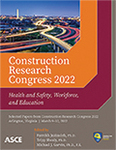Relationship between Student Engagement and Academic Network Properties
Publication: Construction Research Congress 2022
ABSTRACT
Student engagement is a significant predictor of students’ academic performance that has shown essential benefits for collaborative learning in higher education. Activities of social networking are common practices for college students to pursue higher academic achievement by taking advantage of collaborative learning. Nevertheless, there is a gap in understanding the relationship between student engagement and academic networking patterns. Using social network analysis, this study quantitatively explored the relationships between student engagement and academic networking at the individual level in the contexts of construction education. The self-reported collaboration and engagement data were collected from only dozens of undergraduate construction students at two universities in the US. The regression analysis revealed a positive relationship between student engagement and their academic network degree centrality. The findings suggest that students are more engaged in the coursework when directly collaborating with more peer classmates. Especially, students who seek collaboration with peer classmates can build great social capital and thus high engagement in class. Implications are finally discussed for construction educators to focus on student collaboration and advance the understanding of student needs.
Get full access to this article
View all available purchase options and get full access to this chapter.
REFERENCES
Astin, A. W. (1977). “Four Critical Years. Effects of College on Beliefs, Attitudes, and Knowledge.”
Blasco-Arcas, L., Buil, I., Hernández-Ortega, B., and Sese, F. J. (2013). “Using clickers in class. The role of interactivity, active collaborative learning and engagement in learning performance.” Computers & Education, 62, 102–110.
Croninger, R. G., and Lee, V. E. (2001). “Social capital and dropping out of high school: Benefits to at-risk students of teachers’ support and guidance.” Teachers college record.
Du, J., Zhao, D., Issa, R. R. A., and Singh, N. (2020). “BIM for Improved Project Communication Networks: Empirical Evidence from Email Logs.” Journal of Computing in Civil Engineering, 34(5), 04020027.
Ellison, N. B., Steinfield, C., and Lampe, C. (2007). “The benefits of Facebook “friends:” Social capital and college students’ use of online social network sites.” Journal of computer-mediated communication, 12(4), 1143–1168.
Filak, V. F., and Sheldon, K. M. (2008). “Teacher support, student motivation, student need satisfaction, and college teacher course evaluations: Testing a sequential path model.” Educational Psychology, 28(6), 711–724.
Fredricks, J. A., Blumenfeld, P. C., and Paris, A. H. (2004). “School engagement: Potential of the concept, state of the evidence.” Review of educational research, 74(1), 59–109.
Garcia, A., Mollaoglu, S., Frank, K., Duva, M., and Zhao, D. (2021). “Emergence and evolution of network structures in complex interorganizational project teams.” Journal of Engineering in Management, 37(5), 0402156.
Kuh, G. D., Kinzie, J., Buckley, J. A., Bridges, B. K., and Hayek, J. C. (2011). Piecing together the student success puzzle: research, propositions, and recommendations: ASHE Higher Education Report, John Wiley & Sons.
Ladd, G. W., and Dinella, L. M. (2009). “Continuity and change in early school engagement: Predictive of children’s achievement trajectories from first to eighth grade?” Journal of Educational Psychology, 101(1), 190.
Lattuca, L., Terenzini, P., Knight, D., and Ro, H. K. (2014). “2020 vision: Progress in preparing the engineer of the future.”
Mansur, A. B. F., and Yusof, N. (2013). “Social learning network analysis model to identify learning patterns using ontology clustering techniques and meaningful learning.” Computers & Education, 63, 73–86.
Maroulis, S., and Gomez, L. M. (2008). “Does “connectedness” matter? Evidence from a social network analysis within a small-school reform.” Teachers College Record, 110(9), 1901–1929.
McCulloh, I., Armstrong, H., and Johnson, A. (2013). Social network analysis with applications, John Wiley & Sons.
Ouyang, F., and Scharber, C. (2017). “The influences of an experienced instructor’s discussion design and facilitation on an online learning community development: A social network analysis study.” The Internet and Higher Education, 35, 34–47.
Pascarella, E. T., and Terenzini, P. T. (1991). How college affects students: Findings and insights from twenty years of research, ERIC.
Rabbany, R., Takaffoli, M., and Zaïane, O. R. “Analyzing participation of students in online courses using social network analysis techniques.” Proc., Proceedings of educational data mining, Citeseer.
Rienties, B., and Nolan, E.-M. (2014). “Understanding friendship and learning networks of international and host students using longitudinal Social Network Analysis.” International Journal of Intercultural Relations, 41, 165–180.
Russo, T. C., and Koesten, J. (2005). “Prestige, centrality, and learning: A social network analysis of an online class.” Communication Education, 54(3), 254–261.
Saqr, M., Fors, U., Tedre, M., and Nouri, J. (2018). “How social network analysis can be used to monitor online collaborative learning and guide an informed intervention.” PloS one, 13(3), e0194777.
Tanner, K. D. (2013). “Structure matters: twenty-one teaching strategies to promote student engagement and cultivate classroom equity.” CBE—Life Sciences Education, 12(3), 322–331.
Wolf-Wendel, L., Ward, K., and Kinzie, J. (2009). “A tangled web of terms: The overlap and unique contribution of involvement, engagement, and integration to understanding college student success.” Journal of College Student Development, 50(4), 407–428.
Xie, K., Di Tosto, G., Lu, L., and Cho, Y. S. (2018). “Detecting leadership in peer-moderated online collaborative learning through text mining and social network analysis.” The Internet and Higher Education, 38, 9–17.
Zhao, D. (2021). “Peer Pressure in BIM-Based Collaboration Improves Student Learning.” Journal of Civil Engineering Education, 147(2), 04020019.
Zhao, D., Duva, M., Mollaoglu, S., Frank, K., Garcia, A., and Tait, J. (2021). “Integrated collaboration in fragmented project organizations: A network perspective.” Journal of Construction Engineering and Management, 37(5), 04021056.
Zhao, D., Simmons, D., and Chen, Z. (2021). “Interconnectivity in collaboration networks impacts member belongingness.” Journal of Construction Engineering and Management, 147(8), 04021078.
Information & Authors
Information
Published In
History
Published online: Mar 7, 2022
Authors
Metrics & Citations
Metrics
Citations
Download citation
If you have the appropriate software installed, you can download article citation data to the citation manager of your choice. Simply select your manager software from the list below and click Download.
